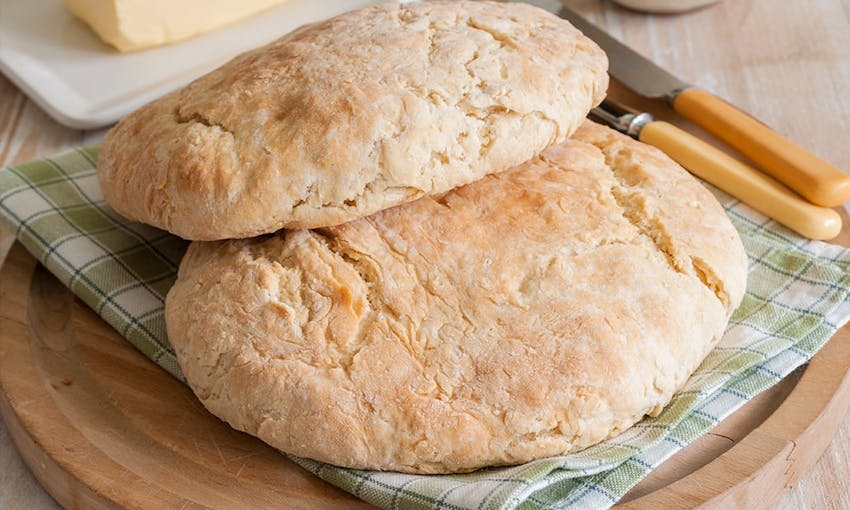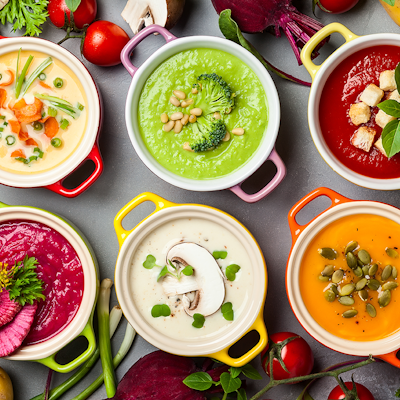What to Eat with your Favourite Breads
In celebration of Real Bread Week we’re looking at the best things to pair with your favourite loaves…
It’s nearly Real Bread Week, the annual celebration of additive-free loaves and the people who make them organised by Real Bread Campaign. And we’re joining in the fun – but not only do we want to celebrate bread in all its many forms, we also want to salute the foods that make bread taste even better, so we’ve put together this guide to the perfect accompaniments to our favourites…
Stottie Cake
What it is: Rarely found in the South of England, the stottie cake is native to Newcastle and the surrounding areas, with its name coming from the Northern word “stot” – which means to bounce. A good stottie should bounce off the floor.
Why we love it: Stottie is a filling, satisfying kind of bread – its heavy, dough-like texture comes from being only proven once, and cooked as low down as possible in the oven.
The perfect accompaniment: Stottie is a sandwich bread, and nothing goes better with it than pease pudding – another delicacy of the Northeast. Throw in some ham to add bite to the softness and smoothness of the stottie-pease pudding combination, then cut into triangles using the handy indentations on the top of the bread.
Soda Bread
What it is: Commonly associated with Ireland (where locals have been known to eat it with every meal), and popular in the US, soda bread is a quick and easy to make loaf that uses sodium bicarbonate as a leavening agent instead of yeast.
Why we love it: Its mild, almost biscuit-like flavour and cakey texture make it a versatile bread that’s always handy to have around – it can be used for sandwiches, cooking, and as an accompaniment to your evening meal.
The perfect accompaniment: Soda bread is best served warm with butter, but for added zing we’d suggest adding marmalade where the sharp and sweet tang will complement the bread’s heartiness.
Focaccia
What it is: A flat, oven-baked Italian bread, most people associate focaccia with the flavour of rosemary – which it’s often cooked with. But what really makes a true focaccia is a crisp and salty crust combined with a soft, springy crumb.
Why we love it: As a bread that manages to be simultaneously spongy and light, and chewy and rich, focaccia always feels like a real treat, plus its consistency makes it perfect for mopping up oil and sauces from your plate.
The perfect accompaniment: Channel Italians and revel in simplicity when it comes to this bread – simply top with olive oil and salt, adding thinly sliced onion or pancetta if you can’t resist a flourish.
Crumpets
What it is: A small griddle cake historically cooked on an iron plate over a fire, despite its oh-so-English reputation the crumpet is thought to have its origins in Wales.
Why we love it: The crumpet’s distinctive, hole-filled texture means it acts like a butter sponge. With a hard golden crust and soft crumb, each bite is a silky piece of heaven.
The perfect accompaniment: A hot crumpet only needs lots of thick, salty butter to be the perfect snack at breakfast or afternoon tea.
Brioche
What it is: Not quite sweet, not quite savoury, French brioche is an almost pastry-like bread and dates back to 1404.
Why we love it: Brioche has a high butter and high egg content which give it a rich flavour – yet its extremely light and fluffy inside, with a paper-thin crust. So it feels deliciously indulgent but not too indulgent.
The perfect accompaniment: For a real treat make brioche French toast, by dipping in a mixture of sugar, vanilla extract, butter and milk, then frying. Serve with Maple syrup.
Bagel
What it is: The bagel comes from Poland, where it was eaten by Ashkenazi Jews since the 17th century and was even said to be given as a gift to women in childbirth. Each bagel should be shaped by hand and the yeasted wheat dough boiled before being oven baked.
Why we love it: A browned, crisp shell that gives way to a chewy dense inside – bagels have a distinctive taste and texture that compliment certain foods in a way nothing else ever could. Which leads us to…
The perfect accompaniment: A bagel with cream cheese is practically the official cuisine of New York and is sometimes known as ‘a whole schmear’. The smoothness of the cheese and the chewiness of the bagel belong together.
Sourdough
What it is: A hard, chewy bread whose pleasant, sour taste comes from the fermentation of dough using naturally occurring yeast. It might seem as though sourdough has only boomed in popularity in recent years, but it actually dates back as far as 3700BCE.
Why we love it: Sourdough fermentation is known to improve the texture quality of gluten-free bread, and the fermentation process also improves its shelf life, and gives it more protein-content and antioxidants than other breads.
The perfect accompaniment: As one of the sturdiest, densest breads around, sourdough makes a perfect bread bowl for serving soup, especially something flavourful like spicy tomato or ham and pea.
Pumpernickel
What it is: Hailing from Germany originally, pumpernickel is a heavy, slightly sweet rye bread (made with a sourdough starter and coarsely ground rye) that was once peasant food and is now a delicatessen staple.
Why we love it: Pumpernickel is one of the best breads for diabetics, as it has a low glycemic index. This also means it can lower the risk of heart disease and potentially aid weight loss
The perfect accompaniment: Eat with sliced tomato and cucumber for a fresh crunch to contrast with the heavy, rich taste of the bread.
Bannock Cake
What it is: A flat, quick bread popular in Northern England, Scotland and Ireland, that was even mentioned by Robert Burns in one of his poems. There are also myths that bannock cakes were once used in deciding who to use as a human sacrifice.
Why we love it: Bannock cake has a texture like a scone or a biscuit, with a fluffy centre and a rustic quality that makes it fun – it’s meant to be cooked in an iron skillet over and open fire, for instance a campfire or a fireplace.
The perfect accompaniment: As originally intended, with a hot, hearty stew.
Matzo
What it is: An unleavened flatbread that is a major part of traditional Jewish cuisine, and integral to the faith’s Passover festival. For that occasion it must be made from flour and water, though the flour can be wheat, spelt, barley or rye.
Why we love it: Matzo is a highly adaptable bread, that can be light and fluffy and absorbent, or heavy and spongy depending on how you cook it and how you like it.
The perfect accompaniment: Matzo balls in chicken soup are a Jewish delicacy and the ultimate comfort food.



